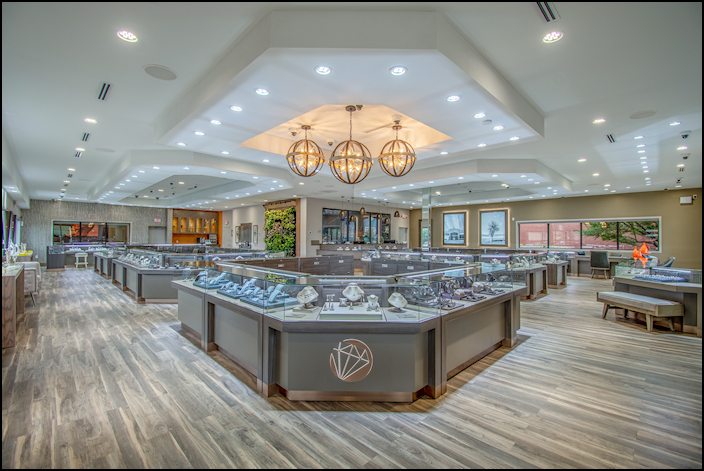Interior Design: Key Aspects to Jewelry Store Interior Design & Profits

First Impressions Matter –The layout of a store sets the stage for a customer’s shopping experience. This first impression is crucial. An inviting and well-organized layout can entice customers to explore further, while a cluttered or confusing one can discourage them from spending time in the jewelry store. The way that customers feel upon entering your place can greatly influence whether they make a purchase.
Customer Flow and Navigation – An effective layout guides customers through the store in a logical and intuitive manner. Jewelers often use techniques like strategic jewelry placement, signage, and aisle layout to encourage customers to move through the store and discover their products. A well-designed flow can help expose customers to a wider range of merchandise and increase the likelihood of impulse purchases. (as shown in above image of Occasion’s Fine Jewelry).
Product Visibility and Accessibility– How visible and accessible your jewelry is a critical factor in driving sales. The jewelry items that are prominently displayed and easy to reach are more likely to sell. Businesses strategically place high-demand or high-margin jewelry at jewelry cases that are slightly below eye level, while lower-demand items may be placed on different cases. This ensures that customers can quickly spot and access the jewelry they want.
Cross-Selling and Upselling Opportunities- A well-planned store layout can facilitate cross-selling and upselling by suggesting related or complementary jewelry based on customers’ current selections. This can lead to customers walking out of the jewelry store with more items than they originally intended to purchase. By placing complementary jewelry near each other, jewelers can encourage customers to purchase additional jewelry.
Creating Shopping Zones -Jewelers often create distinct shopping zones within their stores, which makes the shopping experience easier. This zoning helps customers find what they need more efficiently and encourages them to explore different jewelry categories, ultimately leading to increased sales.
Emotional Connection and Brand Experience- Store layouts can also convey a jewelry store’s brand and evoke emotions. For example, a high-end jewelry boutique might use luxurious jewelry and minimalist design to create an atmosphere of exclusivity, prioritize bright colors gems and interactive displays. These design choices can influence how customers perceive the brand and how emotionally connected they feel to it.
Checkout Process –The checkout area is a critical component of the jewelry store layout. It’s often strategically positioned to ensure that customers must pass by additional jewelry before making their final purchase. Jewelers also optimize the checkout process to be as smooth and efficient as possible, reducing wait times.








